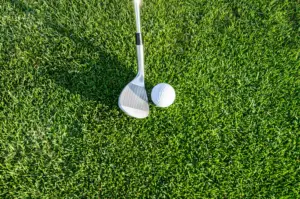Golf is a game that requires precision and skill, and one of the most impressive shots to master is the ability to put backspin on a golf ball. The sight of a ball landing on the green and then spinning back towards the hole is a testament to a golfer’s control and finesse. In this comprehensive guide, we will explore the techniques and strategies to help you master the art of backspin in golf.
Understanding the Importance of Backspin
Before delving into the techniques, it’s essential to understand why backspin is crucial in golf. Backspin refers to the backward rotation of a golf ball as it flies through the air. There are two primary reasons why backspin is important for a golf shot:
- Lift and Control: Backspin helps create lift on the golf ball, allowing it to travel farther. The dimples on the surface of the golf ball play a crucial role in creating lift. Without enough backspin, the ball won’t achieve optimal lift, resulting in shorter shots. Backspin also provides control over the ball’s trajectory, allowing golfers to shape their shots and navigate obstacles.
- Stopping Power: Backspin helps control the ball once it lands on the ground, especially on the green. When hitting a ball into the green, golfers want it to stop quickly to avoid overshooting the target. Backspin enables the ball to grip the green, preventing it from rolling too far. This level of control is particularly advantageous in the short game, where precision is key.
Factors That Impact Backspin
To effectively generate backspin on a golf ball, several factors come into play. Understanding and mastering these elements will greatly enhance your ability to put backspin on the ball. Let’s take a closer look at each factor:
Angle of Attack
The angle of attack refers to the line your club head takes to make contact with the golf ball. To achieve backspin, you need a steeper angle of attack, which means striking the ball with a downward motion. This downward strike compresses the ball against the clubface, creating the necessary spin.
Club Selection
The choice of club is crucial when it comes to generating backspin. Higher lofted clubs, such as wedges, are easier to use for backspin shots. The increased loft helps create a higher launch angle, allowing the ball to stay in the air longer and generate more backspin upon landing.
Club Face Angle
The club face angle at impact plays a significant role in backspin generation. To create backspin, it is essential to have a square club face at the point of contact with the ball. An open or closed club face will result in side spin rather than backspin, affecting the ball’s trajectory.
Clean Grooves
The condition of your club’s grooves affects your ability to generate backspin. Clean grooves provide better contact between the clubface and the ball, allowing for maximum spin. Regularly clean your clubs and consider replacing your wedges every few years to maintain optimal groove performance.
Ball Position
The position of the ball in your stance can impact your ability to generate backspin. Placing the ball slightly closer to your back foot encourages a steeper angle of attack, increasing the chances of creating backspin. Experimenting with ball position can help you fine-tune your shots.
Swing Speed
Swing speed plays a crucial role in generating backspin. A faster swing speed at impact results in more spin on the ball. However, it’s essential to find the right balance between power and control. Swinging too hard can lead to a loss of accuracy, so focus on maintaining a smooth and controlled swing.
Course Conditions
The condition of the grass on the course can affect your ability to generate backspin. Shorter grass, like the fairway, allows for cleaner contact with the ball, promoting better backspin. In contrast, longer grass in the rough can make it more challenging to generate spin. Be aware of the course conditions and adjust your technique accordingly.
Golf Ball Selection
The type of golf ball you use can also impact your ability to generate backspin. Golf balls designed for spin, often referred to as “tour” or “soft” balls, have a softer cover and core, allowing for more spin. Consider using these types of balls when practicing your backspin shots.
Techniques to Enhance Backspin
Now that we’ve explored the factors that influence backspin, let’s dive into the techniques that can help you enhance your backspin shots. By incorporating these strategies into your practice sessions, you’ll be on your way to mastering the art of backspin in golf.
Angle of Attack
To achieve a steeper angle of attack, focus on striking the ball with a downward motion. Imagine sweeping the ball off the turf rather than trying to lift it into the air. Practice hitting down on the ball during your swing, ensuring clean contact with the clubface.
Grip and Club Control
Maintain a firm grip on the club throughout your swing. A weak grip can lead to an open clubface, reducing the amount of backspin generated. Practice gripping the club securely and maintaining control throughout your swing.
Clean and Sharp Grooves
Regularly clean your club’s grooves to ensure optimal spin performance. Use a groove brush or a tee to remove any debris. If your wedges are worn, consider getting them resharpened or investing in new ones to maximize spin potential.
Ball Position and Weight Distribution
Experiment with ball position to find the optimal placement for generating backspin. Generally, placing the ball slightly closer to your back foot can encourage a steeper angle of attack. Additionally, shift your weight slightly towards your front foot to facilitate a downward strike.
Controlled Swing Speed
Maintain a controlled and smooth swing throughout your shot. Focus on generating clubhead speed through proper sequencing of your body and arms, rather than swinging excessively hard. A controlled swing allows for better contact and spin control.
Practice with Different Clubs
Experiment with different clubs to find the ones that work best for generating backspin. Start with higher lofted clubs, such as wedges, and gradually work your way down to shorter irons. Each club requires slightly different techniques, so take the time to practice and refine your shots with each one.
Focus on Technique, Not Power
Remember, generating backspin is not solely about power. It’s about the proper technique and execution. Focus on the fundamentals, such as a steeper angle of attack and clean contact, rather than trying to overpower the shot. With consistent practice, your technique will improve, leading to better backspin shots.
Practice Drills
Incorporate practice drills into your training routine to enhance your backspin skills. Here are a few drills to try:
- Tee Drill: Place a tee about ½” in front of the ball and another tee on the outside of the ball. Practice hitting the ball cleanly and taking a divot after impact while avoiding contact with the tees. This drill helps promote a steeper angle of attack and clean contact.
- Impact Bag Drill: Use an impact bag or a heavy pillow as a target. Focus on hitting the bag with a square clubface at impact. This drill helps reinforce proper clubface alignment and encourages a downward strike.
- Weighted Club Drill: Incorporate a weighted club or donut attachment into your practice routine. Swinging a heavier club can help build strength and increase swing speed, leading to more backspin potential.
Conclusion
Mastering the art of backspin in golf takes time, practice, and a solid understanding of the factors that influence spin. By focusing on the techniques outlined in this guide and incorporating them into your training regimen, you’ll be well on your way to becoming a golfer who can effortlessly put backspin on a golf ball. Remember to be patient, stay consistent with your practice, and enjoy the journey of improving your backspin skills on the course.




